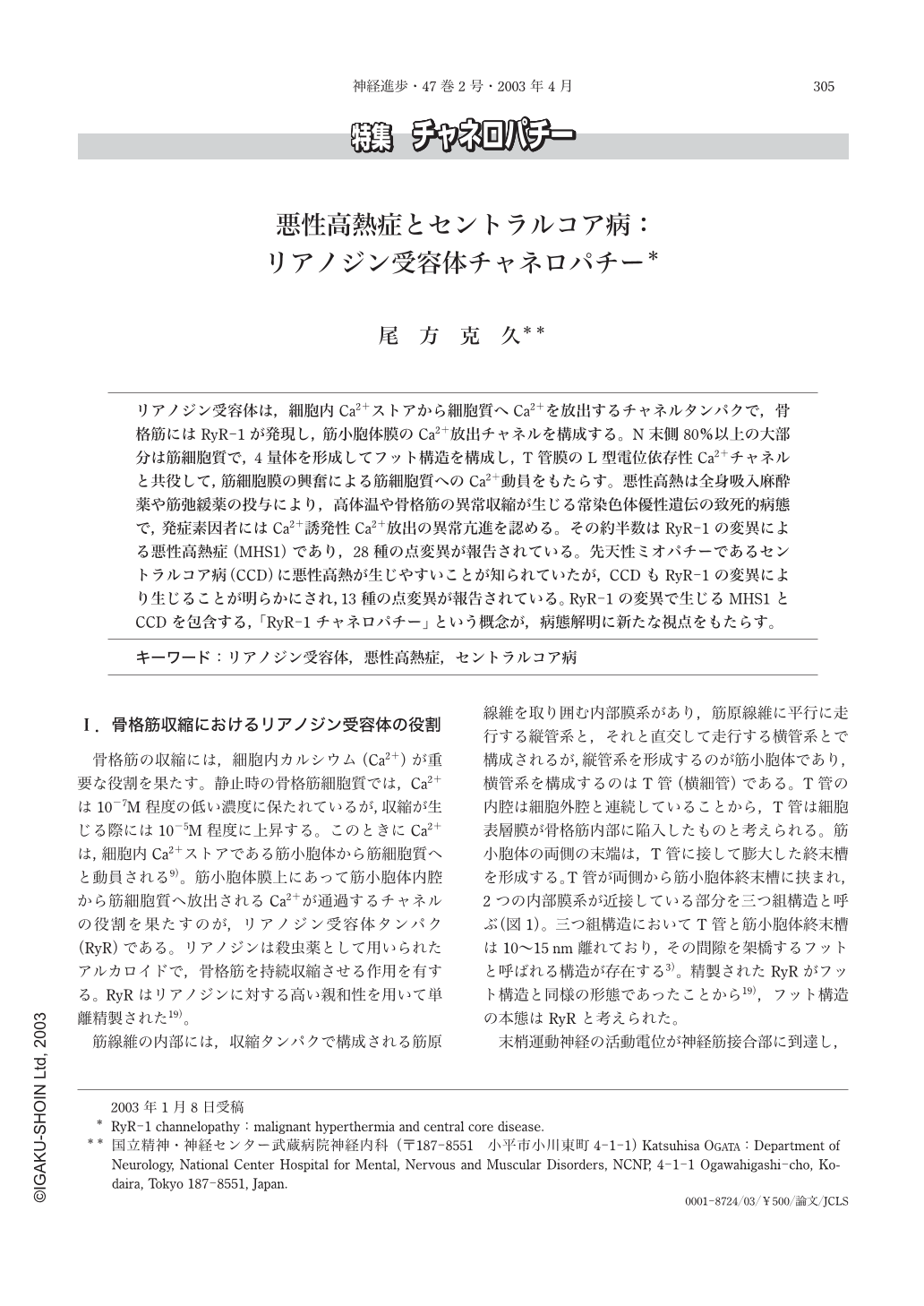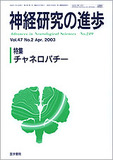Japanese
English
- 有料閲覧
- Abstract 文献概要
- 1ページ目 Look Inside
リアノジン受容体は,細胞内Ca2+ストアから細胞質へCa2+を放出するチャネルタンパクで,骨格筋にはRyR-1が発現し,筋小胞体膜のCa2+放出チャネルを構成する。N末側80%以上の大部分は筋細胞質で,4量体を形成してフット構造を構成し,T管膜のL型電位依存性Ca2+チャネルと共役して,筋細胞膜の興奮による筋細胞質へのCa2+動員をもたらす。悪性高熱は全身吸入麻酔薬や筋弛緩薬の投与により,高体温や骨格筋の異常収縮が生じる常染色体優性遺伝の致死的病態で,発症素因者にはCa2+誘発性Ca2+放出の異常亢進を認める。その約半数はRyR-1の変異による悪性高熱症(MHS1)であり,28種の点変異が報告されている。先天性ミオパチーであるセントラルコア病(CCD)に悪性高熱が生じやすいことが知られていたが,CCDもRyR-1の変異により生じることが明らかにされ,13種の点変異が報告されている。RyR-1の変異で生じるMHS1とCCDを包含する,「RyR-1チャネロパチー」という概念が,病態解明に新たな視点をもたらす。
Malignant hyperthermia(MH)and central core disease(CCD)are both resulted from point mutations in skeletal type ryanodine receptor, RyR-1. RyR-1 consists of C-terminal Ca2+release channel in the membrane of the sarcoplasmic reticulum(SR)and N-terminal large sarcoplasmic domain named the foot structure, both play an essential role for excitation-contraction coupling in skeletal muscle. Deporalization of the transverse tubules induces direct interaction between L-type voltage-gated calcium channels in the membrane of the transverse tubule and the homotetrameric foot structure of RyR-1, which mediates Ca2+release from SR to sarcoplasm and triggers skeletal muscle contraction. Human RYR1 gene is 160 kb with 106 exons for a 15.3 kb mRNA, which is predicted to encode 565 kDa RyR-1 protein composed of 5,038 amino acids. MH is a heterogeneous life-threatening response of skeletal muscles to anesthetic triggering agents. Increase of the Ca2+-induced Ca2+release rate is detected with skeletal muscles of MH cases, suggesting that elevation of sarcoplasmic Ca2+causes MH reaction. Over 50%of the autosomal dominant MH pedigrees show linkage to RYR1, the locus of MHS1. CCD, closely associated with MH, is an congenital myopathy of commonly autosomal dominant trait characterized by hypotonia and muscle weakness with microscopic‘core structures’in muscle fibers. The association among MH and CCD revealed genetic allelism of these two disorders. To date, 31misssense mutations and 2 small deletions of RYR1 have been reported with MHS1/CCD. Only single substitutions or small deletions of amino acids are predicted with these mutations, suggesting RyR-1 is an indispensable molecule. Most of these mutations are clustered in N-terminal residues 35-614, mid-region residues 2163-2458, and C-terminal residues composing Ca2+release channel. N-terminal and mid-region clusters are located in the foot structure, which do not overlap with binding sites for any ligands or interacting proteins. It suggests that interaction with some proteins like voltage-gated calcium channels, FKBP12 or calmodulin, is essential for the function of RyR-1. Many mutations of MHS1 were found in the foot structure, in contrast to the mutations associated with CCD which tend to be reported in the Ca2+release channel region. The molecular mechanism of segregation between MH and CCD phenotypes remained obscure. Some cases of MHS1 showed subclinical findings of myopathy or mild myopathological changes like core structures, suspected as borderline cases of CCD. Consequently, MHS1 and CCD should be recognized together as‘RyR-1 channelopathy’.

Copyright © 2003, Igaku-Shoin Ltd. All rights reserved.


